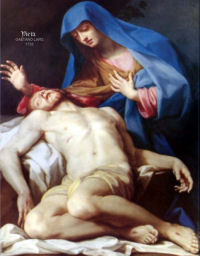
115. On New Year's Day, the octave day of Christmas, the Church celebrates the Solemnity of the Holy Mother of God. The divine and virginal motherhood of the Blessed Virgin Mary is a singular salvific event: for Our Lady it was the foretaste and cause of her extraordinary glory; for us it is a source of grace and salvation because "through her we have received the Author of life"(127).
The solemnity of the 1 January, an eminently Marian feast, presents an excellent opportunity for liturgical piety to encounter popular piety: the first celebrates this event in a manner proper to it; the second, when duly catechised, lends joy and happiness to the various expressions of praise offered to Our Lady on the birth of her divine Son, to deepen our understanding of many prayers, beginning with that which says: "Holy Mary, Mother of God, pray for us, sinners".
116. In the West, 1 January is an inaugural day marking the beginning of the civil year. The faithful are also involved in the celebrations for the beginning of the new year and exchange "new year" greetings. However, they should try to lend a Christian understanding to this custom making of these greetings an expression of popular piety. The faithful, naturally, realise that the "new year" is placed under the patronage of the Lord, and in exchanging new year greetings they implicitly and explicitly place the New Year under the Lord's dominion, since to him belongs all time (cf. Ap 1, 8; 22,13)(128).
A connection between this consciousness and the popular custom of singing the Veni Creator Spiritus can easily be made so that on 1 January the faithful can pray that the Spirit may direct their thoughts and actions, and those of the community during the course of the year(129).
117. New year greetings also include an expression of hope for a peaceful New Year. This has profound biblical, Christological and incarnational origins. The "quality of peace" has always been invoked throughout history by all men, and especially during violent and destructive times of war.
The Holy See shares the profound aspirations of man for peace. Since 1967, 1 January has been designated "world day for peace".
Popular piety has not been oblivious to this initiative of the Holy See. In the light of the new born Prince of Peace, it reserves this day for intense prayer for peace, education towards peace and those value inextricably linked with it, such as liberty, fraternal solidarity, the dignity of the human person, respect for nature, the right to work, the sacredness of human life, and the denunciation of injustices which trouble the conscience of man and threaten peace.







 This feast dates back to the 12th century. It was especially promoted by the Cistercians and the Servites, so much so that in the 14th and 15th centuries it was widely celebrated throughout the Catholic Church. In 1482 the feast was added to the Missal under the title of "Our Lady of Compassion." Pope Benedict XIII added it to the Roman Calendar in 1727 on the Friday before Palm Sunday. In 1913, Pope Pius X fixed the date on September 15. The title "Our Lady of Sorrows" focuses on Mary's intense suffering during the passion and death of Christ. "The Seven Dolors," the title by which it was celebrated in the 17th century, referred to the seven swords that pierced the Heart of Mary. The feast is like an octave for the birthday of Our Lady on September 8th.
This feast dates back to the 12th century. It was especially promoted by the Cistercians and the Servites, so much so that in the 14th and 15th centuries it was widely celebrated throughout the Catholic Church. In 1482 the feast was added to the Missal under the title of "Our Lady of Compassion." Pope Benedict XIII added it to the Roman Calendar in 1727 on the Friday before Palm Sunday. In 1913, Pope Pius X fixed the date on September 15. The title "Our Lady of Sorrows" focuses on Mary's intense suffering during the passion and death of Christ. "The Seven Dolors," the title by which it was celebrated in the 17th century, referred to the seven swords that pierced the Heart of Mary. The feast is like an octave for the birthday of Our Lady on September 8th. 




